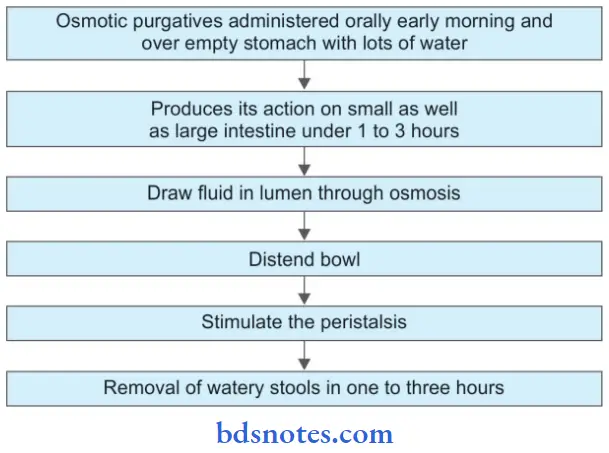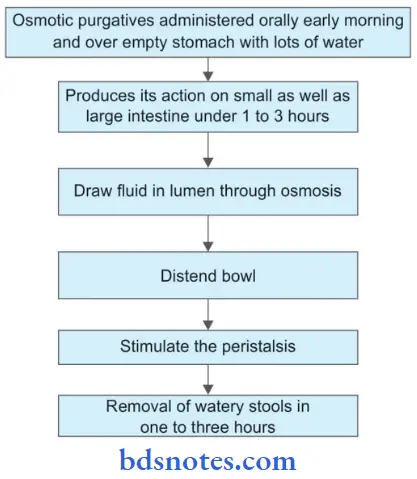Drugs For Constipation And Diarrhea
Question 1. Write Classification And Uses Of Purgatives.
Or
Describe The Uses Of Purgatives.
Or
Write In Brief About The Therapeutic Uses Of Purgatives.
Answer:
Purgatives are drugs that promote defecation and they are used in the treatment of constipation.
Classifiation Of Purgatives
- Bulk-forming: Dietary fire-bran, ispaghula, psyllium, methylcellulose.
- Fecal softeners: Docusates, liquid paraffin
- Stimulant purgative:
- Diphenylmethanes: Phenolphthalein, bisacodyl, and sodium pico sulfate
- Anthraquinones: Senna, cascara sagrada
- 5HT4 agonist: Prucalopride
- Fixed oil, castor oil.
Read And Learn More: Pharmacology Question And Answers
- Osmotic Purgatives:
- Magnesium salts: Magnesium sulfate, magnesium hydroxide,
- Sodium salts: Sodium sulfate, sodium phosphate, sodium potassium tartrate
- Lactulose.
Uses Of Purgatives
- Bulk-forming purgatives or docusate are used in simple constipation and when straining at stools has to be avoided.
- Bulk purgatives are also used in acute functional constipation.
- Fecal softeners such as docusate increase the absorption of nonabsorbable drugs.
- Liquid paraffin lubricants hard stool by coating it.
- Osmotic purgatives are used to prepare the bowel before surgery, food poisoning, and after a purge in tapeworm infestation.
- Saline purgatives are used in fleshing out antihelminthic drugs and helminths.
- Saline purgatives are used in food or drug poisoning.
- Lactulose is used to treat constipation in children and pregnant women.
- Lactulose is given in patients with hepatic coma to reduce blood ammonia levels.
Question 2. Give Pharmacological Explanation To Treat Constipation, Caster Oil Emulsion Is Given In The Morning While Liquid Paraffin Is Administered In Night.
Answer:
Caster oil emulsion is a stimulant purgative and its site of action is the small intestine.
Purgation occurs in 2–3 hours and semi-flid motion occurs, that’s why they are used in the morning while liquid paraffin acts for a longer duration and forms a sludgy layer around.
The feces due to which defecation will become easier. That’s why caster oil emulsion is given in the morning while liquid paraffin is given at night.
Question 3. Write A Short Note On Liquid Paraffin.
Answer:
Liquid paraffin is mineral oil and is administered orally. Liquid paraffin is a stool softener:
- It is an inert viscous liquid that lubricates hard stool by coating it.
- Liquid paraffin is difficult to swallow.
Liquid ParaffinTherapeutic Uses
- It is indicated in patients with cardiac diseases as it prevents straining during defecation.
- It is indicated in bedridden patients
Liquid Paraffin Adverse Effects
- During aspiration, liquid paraffin causes lipid pneumonia.
- During chronic use deficiency of fat-soluble vitamins.
- Liquid paraffin is embarrassing to patients as it leaks out from the oral anal sphincter
- It carries away fat-soluble vitamins with it into the stools due to which deficiency of fat-soluble vitamins may occur on chronic use.
- It can interfere with healing in the anorectal region.
Question 4. Give A Description Of Antidiarrheal Drugs.
Answer:
Diarrhea is too frequent passage of poorly formed stool and is due to excess water in feces.
Antidiarrheal drugs are those which are used in the treatment of diarrhea.
Classification Of Antidiarrheal Drugs
- Antibiotics: Ciprofloxacin, norfloxacin, tetracycline, cotrimoxazole, metronidazole.
- Antisecretory and antimotility drugs
-
- Opioids: Codeine, diphenoxylate, loperamide
- α-adrenergic receptor agonist: Clonidine
- Octreotide
- Racecadotril
- Oral and parenteral rehydration.
Antidiarrheal Drugs Description Of Drugs
Codeine: Codeine decreases gastrointestinal motility and leads to constipation.
Diphenoxylate: This drug has abuse liability, it is available in combination with a small dose of atropine to discourage abuse or overdosage.
Loperamide: Loperamide interacts with μ opioid receptors in the gut. Loperamide decreases gastrointestinal motility and increases anal sphincter tone. It is used in both acute and chronic diarrhea.
Clonidine: It has both antisecretory and antimotility effects. It is indicated in diarrhea due to opioid withdrawal and in diabetics with autonomic neuropathy.
Octreotide: This drug is of much use in secretory diarrhea due to hormone-secreting tumors of the GIT and pancreas. Octreotide inhibits the secretion of 5 hydroxytryptamines, vasoactive intestinal peptides, gastrin, etc. It is given either IV or SC. It is also used in the treatment of diarrhea in patients suffering from AIDS.
Racecadotril: Racecadotril is a prodrug converted into an active metabolite enkephalinase inhibitor and inhibits the degradation of enkephalins in intestinal mucosa and increases the concentration of enkephalins in the intestinal mucosa, this decreases intestinal secretion. This drug is very useful in acute secretory diarrheas. This drug is useful in children.
Question 5. Write A Short Note On ORS.
Answer:
ORS or oral rehydration solution is given in oral rehydration therapy of mild to moderate diarrhea.
- Composition Of ORS
NaCl 3.5 gm
KCl 1.5 gm
Na citrate 2.9 gm
Glucose 20 gm
Above all compounds are dissolved in 1 L of water.
The action of each component in composition:
- Glucose facilitates sodium reabsorption.
- Na citrate corrects acidosis and promotes sodium and water absorption.
- KCl is given to compensate for K+ ion loss in diarrhea.
- New WHO ORS Formula.
NaCl 2.6 gm
KCl l.5 gm
Na Citrate 2.9 gm
Glucose 13.5 gm
Water 1 L
In the new WHO ORS formula, the quantity of sodium and glucose is less. This is because sodium causes periodical edema and high glucose increases stool volume.
Uses/Indications Of ORS
- ORS decreases stool volume and vomiting.
- ORS helps in reviving from Cholera.
- It is useful in heat stroke and the maintenance of hydration in burn patients.
- It is useful in severe diarrhea with dehydration.
- As per WHO zinc should be given with ORS for 10 to 14 days in acute diarrhea in children.
Super ORS
Boiled rice powder is added to ORS as a substitute for glucose. This is because it decreases stool volume and stimulates salt and water reabsorption which helps in rehydration and decreases the frequency of diarrhea.
Question 6. Describe Their Indications And Contraindications. Mention The Adverse Effects Of One Purgative.
Answer:
Purgative Contraindications
- Purgatives are contraindicated in pregnant women.
- They are contraindicated in persons during anesthesia.
Adverse Effects Of One Purgative
The adverse effects of liquid paraffin are as follows:
- It is unpleasant to swallow due to its oily consistency.
- While swallowing it may trickle into the lungs and causes lipid pneumonia.
- It carries away fat-soluble vitamins into the stools.
- It may interfere with healing in the anorectal region.
Question 7. Enumerate And Write The Mode Of Actions Of AntiMotility Drugs In Diarrhea.
Answer:
The antimotility drugs in diarrhea are:
- Codeine
- Diphenoxylate
- Loperamide.
Diarrhea Mode of Action
- These drugs increase small bowel tone and segmenting activity, reduce propulsive movements and diminish intestinal secretion while enhancing absorption.
- Loperamide interacts with μ opioid receptors inside the gut. It decreases the gastrointestinal motility and increases the anal sphincter tone.
Question 8. Write A Short Note On Osmotic Purgative.
Answer:
Osmotic purgatives are drugs for constipation.
Types Of Osmotic Purgatives
Magnesium salts: Magnesium sulfate, Magnesium hydroxide.
Sodium salts: Sodium sulfate, Sodium phosphate, Sodium potassium tartrate, and lactulose.
Osmotic Purgative Mechanism of Action

Magnesium ions release cholecystokinin which may aid the purgative action of magnesium salts.
Dosing Of Various Osmotic Purgatives
- All inorganic salts used as osmotic (saline) purgatives have similar action-differ only in dose, palatability, and risk of systemic toxicity.
- Magnesium sulfate: 5–15 g; bitter in taste.
- Magnesium hydroxide; is bland in taste, also used as an antacid.
- Sodium sulfate (Glauber’s salt): 10–15 g; bad in taste.
- Sodium phosphate: 6–12 g, taste not unpleasant.
- Sodium potassium tartrate: 8–15 g, relatively pleasant tasting.
- The salts in above mentioned doses, dissolved in 150–200ml of water, produce 1–2 fluid evacuations within 1–3 hours with mild cramping; causing nearly complete emptying of bowels.
- Smaller doses may have a milder laxative action.
Osmotic Purgative Indications
- Functional Constipation
- Bed-ridden patients
- To avoid straining stools
- Preparation of bowel for surgery, colonoscopy, abdominal X-ray
- In food/drug poisoning.
Question 9. Explain Why Loperamide Should Not Be Preferred In Bacterial Diarrhea.
Answer:
Loperamide is an orally active antidiarrheal agent which acts on the μ opioid receptors. The drug has antisecretory activity against the toxins of cholera and some forms of Escherichia coli.
It increases the transit time of the bowel. Loperamide has been shown to increase the anal sphincter tone which is of value in some patients suffering from anal incontinence.
The drug has an additional advantage that it has poor CNS penetration. Loperamide and other antimotility drugs are contraindicated in acute diarrhea caused by invasive organisms as they
- Mask the clinical symptoms
- Delay the clearance of organisms
- Increase the risk of systemic invasion by microorganisms
- May induce local complications like toxic megacolon.

Question 10. Write A Short Note On Dietary Fier.
Answer:
Dietary fibers are bulk-forming purgatives.
- Dietary fibers are Bran, Psyllium, Ispaghula, and methylcellulose.
- Dietary fibers absorb water, swell, and increase the bulk of stools.
- Dietary fibers cause mechanical distention and stimulate peristalsis which promotes defecation.
- Dietary fibers are used in constipation for releasing the strain of stools during defecation.
- Dietary fibers support bacterial growth in the colon which contributes to fecal masses.
- Certain dietary fibers bind to bile acid and promote their excretion in feces due to this degradation of cholesterol in the liver is enhanced and plasma LDL cholesterol is lowered.
Question 11. Write A short note on purgatives.
Answer:
purgatives Bulk Forming
These are the indigestible hydrophilic substances such as bran, methylcellulose, agar, ispaghula which absorb the water swells up and increases the bulk of stools which leads to mechanical distention, stimulate peristalsis and promote defecation.
Large amounts of water should be taken with bulk purgatives to avoid obstruction in the intestine.
Purgatives Stool Softners
- Docusate, i.e. dioctyl sodium sulphosuccinate and dioctyl calcium sulphosuccinate are anionic surfactants that lower the surface tension of stool and leads to the accumulation of fluid and fat substance and soften the stool. They act within 1 to 3 days.
- Liquid paraffin is a mineral oil that is administered orally. It is a stool softener. It lubricates the hard stool by coating it. It is used in patients with cardiac disease as it prevents straining during defecation.
purgatives Stimulant Purgative
These drugs directly act on enteric neurons and gastrointestinal mucosa. These agents increase prostaglandin and cAMP levels but inhibit Na+ K+ ATPase activity in the intestinal mucosa. This causes an increase in the secretion of water and electrolytes by mucosa and stimulates peristalsis. These drugs evacuate semifluid stools.
- Bisacodyl: It is available as an enteric-coated oral tablet and as a rectal suppository. It is poorly absorbed during oral administration and gets activated by esterases in the bowel. Its effect is seen under 6 to 8 hours of oral administration. So it is given at bedtime.
- Anthraquinone derivatives: Senna and cascara are the drugs. They act in 6 to 8 hours so are given at bedtime to produce their effect in the morning. It is poorly absorbed in the small intestine, unabsorbed drug reaches the colon where it is reduced by bacteria to anthro which acts locally and induces purgation.
purgatives Osmotic Purgatives
- Lactulose: On oral administration, this is not absorbed through gastrointestinal mucosa. Colonic bacteria convert it into acidic products which exert an osmotic effect and draw fluid in the lumen and distend it, so it is useful in constipation in children and pregnant women.


Leave a Reply